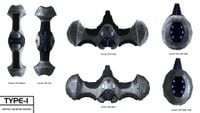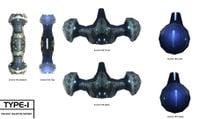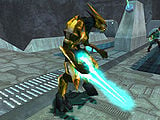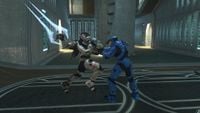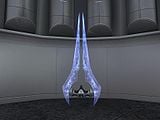Energy sword (fiction)
From Halopedia, the Halo wiki
- "A noble and ancient weapon, wielded by the strongest of Sangheili, requires great skill and bravery to use, and inspires fear in those who face its elegant plasma blade."
- — then-Supreme Commander Thel 'Vadamee [1]
The Type-1 Energy Weapon/Sword, commonly known as the energy sword, is a close quarters weapon of the Covenant Empire exclusively used by the Sangheili.[2][3]
Overview
The Type-1 Energy Weapon/Sword's design is derived from that of the curveblade, a traditional weapon that was used throughout much of the Sangheili's history.[3] The energy sword consists of a curved hilt, which houses an energy storage and generation device, as well as the blade projector; that forms a blade of superheated plasma, stabilized by two small magnetic field generators built into the handle of the weapon — this forms and contains the oval shaped, ionized blades for which the weapon is recognized.[2] The weapon is powered by a small battery that supplies power to the plasma generation device and magnetic field generators which generate and contain the plasma needed to form the blade.[4] The battery's energy is reduced for each successful strike. Each strike from the sword will drain the battery by 10% of its maximum energy output. Once the battery power is fully depleted, the sword will deactivate unless recharged.
The energy sword contains a failsafe mechanism that can permanently disable the weapon if the Sangheili wielding it drops it.[5] When dropped, the failsafe engages by deactivating the magnetic field before dispersing the plasma. The plasma then consumes the handle and thus destroys the weapon.[6] The failsafe is included to prevent enemy infantry from acquiring the weapon and using it, and is yet another insight to Sangheili tactics.
The energy sword is the signature weapon of the Sangheili, and has been their weapon of nobility since its creation during one of their Ages of Discovery.[7] The Sangheili pride themselves on their skills with this weapon, [8] which they regard as holy,[9] and believe that it is better for a Sangheili to fall on his sword as an act to redeem his honor or to die by it.[10][11][9] The Sangheili are also very strict on who can be trained in the art of swordsmanship - only aristocrats are permitted to wield energy swords and sword wielders are no longer eligible for marriage. However, they may breed with any female they choose, married or otherwise, to ensure successful transmission of "swordsman" genes.[12][3] Within the Covenant, Sangheili of lower ranks are generally not permitted to wield the sword because of the high regard in which it is held,[9] though there are some exceptions.[13][14][15][16][17] Ultras, Zealots, special operations units, stealth troops, honor guardsmen, and Arbiters are permitted to use energy swords.
Advantages
The Type-1 Energy Weapon is an extremely powerful and effective melee weapon in close-quarters combat. A single strike can penetrate through the energy shield systems and into the armor and flesh of a SPARTAN or a Sangheili. This is due to the design of the weapon, which utilizes ionized gas rather than traditional shaped, solid matter - because the energy sword lacks any solid material in which to hold, or impale anything, the sword does not cut or carve in the traditional sense, but rather boils anything it comes into contact with.[4] This allows the weapon to pass though any type of material, including the toughest metal, with ease.[18][19]
Injuries to living creatures by the Type-1 Energy Weapon can range from bad to gruesome. Stabs wounds by the Type-1 Energy Weapon are, in most cases, fatal — as the blade passes through the body, the innards of the body are burned and cauterized by the extreme temperatures produced by the blades.[20] Body fluids in the area of the stab wound are flash vaporized upon contact — organs within the area of the stab wounds can suffer life threatening damage dependent upon the type of organ struck, effects of fluids trapped in organs or arteries in addition to the expansion of heat would cause ruptures or small explosions causing additional damage to the victim. Survival is minimal at best and in the case of non-vital organs being stabbed with the energy sword, proper medical treatment must be applied as soon as possible to ensure long-term survival. Because of the sword's sheer destructive power, dismemberment is another common form of fatality to victims, ranging from decapitation[21] to bodies being sliced in half.[18][22] Loss of limbs is a common injury.[23] While not fatal, a victim will require a cloned replacement or a mechanical prosthetic.
The sheer destructive power of the sword makes it a weapon to be feared on any battlefield and is known for its physiological affects on human soldiers.[4] The strength and lethality of the sword in the games are compensated for the sake of gameplay.
Disadvantages
The Type-1 Energy Weapon's main disadvantage is that it is purely a close-quarters weapon, any weapon outside of the effective range puts the wielder at risk. It is for this reason the Sangheili approach sword combat on the battlefield in two different ways, by funneling the enemy into close-quarters to allow them to strike, or to apply a form of stealth using both technology and technique. Without these, the Sangheili is vulnerable to attack by different types of weapons both Human and Covenant. Infantry with overshielding are also more resistant when facing this weapon, as it can take two strikes before the shield system fails.
The Type-1 Energy Weapon is also vulnerable to other magnetic fields, as they can block, disrupt, or possibly even alter the functionality of the sword. Two energy swords clashing together create a small disruption of energy as a result of the same type of magnetic fields clashing together. This clash has a slight area of effect damage that can affect the combatants.
Like most other Covenant weapons, the Type-1 Energy Weapon is battery-powered, requiring the user to either recharge the weapon or discard it when the power is depleted. Although the handle can be used as a club, the Energy Sword's combat effectiveness at that point is minimal, as other firearms can be used for the same purpose.
Gameplay
Changes among games
Changes from Halo: Combat Evolved to Halo 2
In Halo: Combat Evolved, the energy sword has a cyan glow, a far less defined edge and makes a dull clunk when striking an object. It is only used by Spec Ops Sangheili and Zealots. The player cannot wield the energy sword, due to a failsafe mechanism that vaporizes the weapon when it is not released properly (e.g. being dropped upon death) by the sword-wielder.
In Halo 2, the energy sword is blue with purple undertones, with electrical energy crackling on it when the blade is activated. The white glow seen in Halo: Combat Evolved is also replaced with a more glass-like transparency. In the campaign, it is only used by higher-ranking Sangheili, such as special operations units, Ultras and Zealots, though players can now wield the sword. The sword in campaign has a battery and can only be used effectively against a limited number of enemy forces before the battery runs out. The sword is usable in multiplayer with an infinite battery power. The energy sword has two modes of attacking; a lunge attack and a swing attack.
Changes from Halo 2 to Halo 3
In Halo 3, the sword has more of a light cyan tinge, similar to its appearance in Halo: Combat Evolved, but still has a tint of purple near the handle. It also has an angle near the handle, whereas in the two previous games it was curved. Players are now able to parry with the Sword. The power exerted by the swords hitting each other will drain both players' shields, but will not kill them unless one makes the fatal blow. The sword's lunge attack has been reduced for balancing purposes. Aside from these changes in design and functionality, the power of the sword remains unchanged. In multiplayer, the sword now has a limited battery supply.
Changes from Halo 3 to Halo: Reach
In Halo: Reach, the sword resembles closely to the design used in Halo: Combat Evolved, albeit darker in color. When activated, the sword is capable of lighting up the surrounding area. When unused, the sword rests differently on the SPARTAN and Sangheili character models. The energy sword appears to have been balanced out compared to its earlier incarnations, having a slightly faster swing than its Halo 3 incarnation, its lunge attack now does the same damage as a normal swing, the range has been reduced, and can now be blocked by a well-timed normal melee. Players can no longer lunge immediately after a normal swing. The energy sword also has its own assassination animations when used against Elites or Spartans, replacing the Spartan combat knife and the Sangheili energy dagger; these assassinations do not deplete the sword's charge, nor do they count toward the weapon spree medals Sword Spree, Slice 'N Dice or Cutting Crew. Elites also hold the sword back more than a Spartan when used as an active weapon. When a player is playing as an Elite and uses the Energy Sword as a primary weapon, the camera will lower a bit; this is due to the Elite hunching down. Finally, parrying does slight damage and can kill a player.
In other media
In Halo Graphic Novel's The Last Voyage of the Infinite Succor, there is a variety of sword-type weapons hanged on a wall in the dueling chamber of the Seeker of Truth.[24] These range from apparent energy clubs to sickle-like plasma weapons. The swords used by Rtas 'Vadum and Kusovai in their duel change its design a number of times to exhibit the basic structure of the Type-1 with a few slight differences. In the story "Second Sunrise Over New Mombasa", a Sangheili is shown with a very odd, light-pink, sword, with very thin blades.[25]
In Halo Wars, the Arbiter, Ripa 'Moramee, sported two energy swords with modified hilts and hand guards. In Halo Evolutions's Headhunters short story, a new energy sword variant is introduced; it is described of being composed of a reddish energy combined with the white flicker of electricity, which gives it a blood-colored glow.
Tactics
There are two ways a player in Halo 2, Halo 3 and Halo: Reach can attack, the first is to lunge with the energy sword. With this, the player lunges forward at the other player. However, this only works when the aiming reticule is lit red, indicating that the opposing player is within range. The second attack is the simple melee, this performs a quick horizontal or overhanded swipe.
Campaign
- In Halo: Combat Evolved and Halo 2, use the advantage that the Elites need to be close to one to damage the player's energy shield. On higher difficulties, use the Noob Combo to eliminate the energy sword-wielding Elites. With this tactic, one can kill a Elite Honor Guard with a single Plasma Pistol easily in Halo 2, even on Heroic or Legendary.
- In Halo 2 the sword is extremely valuable against Elites in campaign. When facing sword-wielding Elites a sound tactic is to jump and lunge attack them. This will kill them quickly and save one's shields or even life on higher difficulties.
- In both Halo 2 and Halo 3, the energy sword is one of the best anti-Flood weapons, as it will destroy Flood Combat and Pure Forms in one strike (although if an infected Elite still has its shield, it may take two swipes, depending on the difficulty setting).
- When fighting against the Flood, an attack with the energy sword will deplete the battery by a very small amount (about 3%) due to their soft tissue, making it useful for extended durations. Against Infection Forms, no power is drained.
- The energy sword in Halo 2 and Halo 3 can be used to destroy the corpses of Flood Combat Forms so that they cannot be re-infected by Infection Forms. However, the cutting process does drain battery power. Although, any weapon's melee attack can be used to destroy combat form corpses if used enough times, even a depleted energy sword hilt.
- In Halo 3 the energy sword is very hard to come by in the campaign outside of Floodgate, Cortana, and Halo. The player can obtain an energy sword by betraying an Elite ally on The Covenant by sticking him with a grenade (if Mythic is turned on, the Elite can survive a Plasma Grenade and his energy sword can be taken) or by draining the Arbiter's shield during combat (this happens more frequently on higher difficulties). If the player does so, it is a very good weapon against Brutes, although the battery will deplete very quickly.
- In Halo: Reach the sword will knock out the shields of any Elite in one hit on Legendary, and following up with a headshot means that the sword's battery won't deplete. This is an effective strategy on Long Night of Solace, The Package and Pillar of Autumn. The sword is also incredibly effective against Hunters on all difficulties, as a hit anywhere stuns them and a single swipe to the back kills them. Opportunities for this in campaign are limited to The Package, but it is a useful tactic in Firefight.
Multiplayer
- The sword is easily one of the best close range weapons to use in Halo 2. The best tactic is to lay into an enemy player with your secondary weapon getting closer, then when within range perform a quick swipe with the sword for the finishing move. However since there is no way of telling which player has the sword, or no sound way to stop it, it has often been labeled as a cheap tactic.
- Using Active Camouflage with the sword in Halo 2 is not a wise thing to do as the sword in Halo 2 is still visible with it active. In Halo 3 however, using the sword with active camouflage is a sound tactic as it will now cover the sword when picked up.
- In Halo 3 the sword lunge is shorter, and the player cannot perform a quick strike. In addition, the sword's handle is now visible on the character's leg. In order for the sword to be most effective the player must lure a player into a trap where the sword will become effective; camping with the sword in a corner and waiting is the best way to use it to its fullest extent. As a special note, there is a range difference between the B button melee, and the right trigger lunge. The lunge has the maximum range, whilst the B button seems to only work at 1/2 to 3/4 the range. This is, most likely, for balancing, as the B button swings the sword at a much, much faster rate.
- If the enemy controls the sword room in the Halo 3 multiplayer map The Pit, stick to the outer wall. The range is just short of the wall and if you're lucky your opponent will lunge and miss, giving you the perfect opportunity to kill him or her.
Advanced tactics
- It is possible to dodge a lunge from the energy sword. To do this, one must move quickly to the right when facing the lunging opponent, towards the hand which does not hold the sword. Conversely, to prevent your target from dodging your lunge, simply jump; jumping reduces all chances of missing or being dodged by an opponent.
- In Halo 3, a new feature has been added so that players can parry their opponent's sword by meleeing or lunging at the same time. If you pull the right trigger right before the other person makes contact, a parrying electric clash is produced, but you do lose some or all of your shield. However, when you get down to no shields, a sword clash will not affect your health, though your screen will flash bright red. This is sometimes known as "fencing". If you time it well enough the sword fight can last indefinitely. Because it is faster, using the melee attack instead of the lunge is required in this scenario, even for the first hit.
- Jumping can make the energy sword much more fearsome, brutally effective and accurate. Jump and point your reticule down, waiting until it turns red to lunge at the opponent. In Halo: Reach, the armor ability Evade is the most effective to use with the Energy Sword.
- In Halo 2 avoiding a sword lunge is extremely difficult, if timed correctly and with a bit of luck, side stepping in the direction of the enemy players free hand may save your life, however this is often difficult. In Halo 3 avoiding the sword lunge can be done by using either a Brute Shot or a Shotgun, there is still some difficulty in pulling it off, but the odds of killing an enemy player using the Sword is much greater than on Halo 2.
- An extremely useful tactic against other players wielding swords, is to, rather than hitting B twice for two quick melees, is to strike first with a melee, and then finish them on with the lunge. This tactic is much faster than two melees.
- In Halo: Reach, there is a new technique in which a player may block a sword lunge with any weapon they are carrying at the time. This is done by simply meleeing the incoming attack and stopping the attack with a well timed strike. Both players will receive possibly fatal damage from the clash, with the non-sword user taking more damage. This can be used to counter a sword user in close range if you damage them with your gun first.
Trivia
- The energy sword does not appear in Halo 3: ODST, because there are no living Sangheili in the game. However, near the deceased body of a Sangheili in Tayari Plaza, one can find two depleted sword hilts.
- The shape of the energy sword is very similar to the real-life combat weapon, the katara. It was a South Asian weapon and status symbol, similar to the energy sword's symbolisation of status amongst the Elites.
- In 2008, this was to be released by Jasman Toys to go with their other laser tag weapons; the Plasma Pistol and Plasma Rifle. However, its release has been canceled or delayed, possibly because of the sharp tips of the blade, or because Laser Tag is a shooting game, and the Sword is a melee weapon.
- In Halo 2, when you are using both active camouflage and any weapon besides the energy sword, with the energy sword in reserve as your second weapon, and you switch to the sword, before the blade actually displays in full color, there will be a faint outline of the blade already out, as if it's already there and is just camouflaged as well.
- In Halo:Reach if you peform an assassination with an energy sword that has no charge the animation will stay the same but there will be no blades.
- The unique assassinations only work on Elite and Spartan enemies, if used against any other enemy you will pull out your combat knife.
- It was originally going to be usable in Halo: Combat Evolved, but was cut when the game became a First-Person Shooter. [26]
- In the Halo 3 Vidoc Et tu Brute? there is an unfinished animation depicting a Jiralhanae Chieftain wielding an energy sword. This is, however, never seen in the hands of Jiralhanae in the final game.
- The Fable 2: Limited Edition comes with "Hal's Sword", a crystal blade shaped like an Energy Sword for in-game use, to coincide with the use of "Hal's Armor", which resembles MJOLNIR armor. [27]
- In Halo 2 and Halo 3, a glitch can be performed to give the player a Silhouette Sword.
- In Halo 3 and Halo: Reach, seven Forerunner glyphs are visible on each side of the energy sword's hilt.
- It is possible to get a Sword Spree Medal, even a Slice 'N Dice Medal with an energy sword that is out of battery.
- The distinctive shape of the energy sword is apparently based on ceremonial Sangheili swords. In The Duel, Haka is seen wielding a large bladed weapon that is almost aesthetically identical to the energy sword.
- Another possible predecessor of the familiar energy sword is the curveblade, a traditional Sangheili hunting knife. The curveblade closely resembles a shortened, steel, single-bladed energy sword- right down to the shape of its blade, with the same wide, semicurcular part that curls around the handgrip before elongating into a point used for stabbing. In addition, the curveblade apparently predates the introduction of energy swords by some indeterminate amount of time, having been in use for so long that not even the Sangheili have any memory (whether written or as a cultural tradition) of their invention and first usage.
- When it spawns in most multiplayer maps, rather than lying on the ground, it will be floating in mid-air blades pointing up until it is hit by any damage or grabbed by a player. One exception is the Halo 2 Vista exclusive map, Uplift, where it respawns lying down.
- Prior to the release of Halo 3, it was speculated that the Energy Sword would be dual-wieldable, as seen in various non-game material. Some believed this could be balanced, others believed that it would be grossly overpowered, and yet others believed the only difference would be the apparent doubling of the battery. In any case, the final game does not feature the sword as a dual-wieldable weapon. One possibility is that players may dual-wield the sword with a ranged weapon, such as a Plasma Rifle, and this would greatly mitigate the drawbacks of using a sword.
- In Halo: Reach, Sangheili armor now has a built-in energy dagger used to assassinate (serving as an equivalent to the UNSC Combat Knife utilized by Spartans in assassinations). Its appearance is similar to that of the original energy sword. The only differences are that the blade is shorter, is not split at the middle and extends from the top of the wrist rather than from a handle.
- Prior to the creation of the energy sword, Sangheili fought with similarly shaped conventional metal blades.
- In Halo: Reach, if the alert carry trick is used, the sword will be lowered by your side and the left arm will be by your side as well, unlike Halo 2 and 3, where the left arm is in front of the chest.
- In Halo Wars and Halo: Combat Evolved, the energy sword seems to "leak" plasma. This may be due to varying strengths of the plasma containment field, or because the user can modify the plasma's intensity.
Gallery
- HReach-EnergySword-Profile.png
A profile view of the Energy Sword in Halo: Reach.
- Energy Sword Halo3.png
The energy sword as it appears in Halo 3.
- H2-CovEliteEnergySword-transparent.png
The energy sword as it appears in Halo 2.
- Black Sword.JPG
Another view of the energy sword from Halo 3.
- 1221845548 Elites duel wielding energy swords.jpg
Rtas 'Vadum and Kusovai wielding dual energy sword during a training exercise.
- 79621875-Medium.jpg
Two Spartans parrying in the air on Foundry.
A smaller, more compact variant of the standard energy sword called the energy dagger that is used for Assassinations.
An energy sword as it appears in the Halo: Reach Beta.
An energy sword's crosshair as seen in the Halo: Reach Beta.
A red-colored energy sword variant being used by active camouflaged Special Operations Sangheilis.
List of appearances
Sources
- ^ Halo 2: Special Collector's Edition Manual
- ^ a b Bungie.net: Halo Reach Ordnance Guide: T1 EW/S
- ^ a b c Halo Waypoint, Energy Sword
- ^ a b c Halo Encyclopedia page 335
- ^ Halo: First Strike page 74
- ^ Halo: Combat Evolved
- ^ The Covenant Hall of Murals
- ^ Halo Graphic Novel page 12 - 14
- ^ a b c Halo Encyclopedia page 127
- ^ Halo: The Cole Protocol page 53
- ^ Halo: The Cole Protocol page 141
- ^ Bestiarum Sangheili section
- ^ Halo 2, Another Day at the Beach
- ^ Halo Wars, [introductory cinematic
- ^ Halo Legends, The Package
- ^ Halo: Blood Line
- ^ Halo: Reach, campaign level Long Night of Solace
- ^ a b Halo: The Cole Protocol page 84
- ^ Halo: First Strike page 72
- ^ Halo: Evolutions Midnight in the Heart of Midlothian page 91
- ^ Halo: Evolutions Midnight in the Heart of Midlothian page 101
- ^ Halo: Ghosts of Onyx page 360
- ^ Halo: The Cole Protocol page 30
- ^ Halo Graphic Novel, The Last Voyage of the Infinite Succor page 14
- ^ Halo Graphic Novel, Second Sunrise Over New Mombasa page 95
- ^ Halo: Combat Evolved, E3 2000 Announcement Trailer
- ^ http://www.joystiq.com/2008/10/16/fable-2s-spartan-armor-and-energy-sword-pictured/ Joystiq: Fable 2's Spartan armor and energy sword pictured


